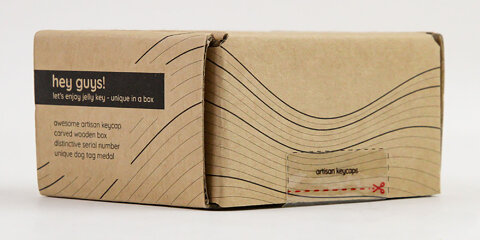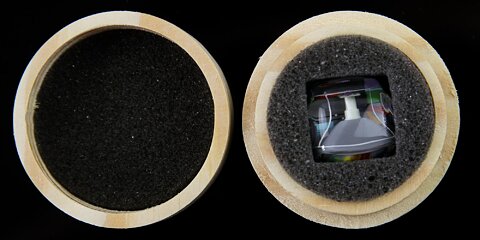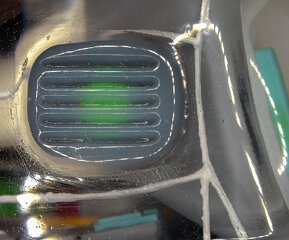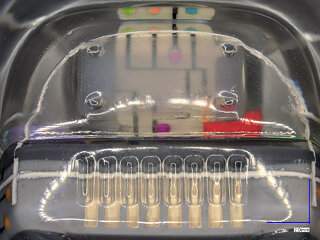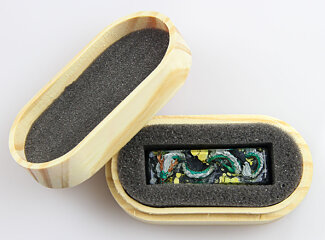 6
6
Quick Look: Jelly Key Retro TV + Dragons of Eden Artisan Keycaps
(6 Comments) »Introduction

Soon after my article covering a set of two Jelly Key artisan keycaps was published, the company got in touch to see if I would be interested in taking a look at a then-upcoming group buy artisan keycap. No thanks to shipping logistics, it arrived later than I wanted, with the group buy already over. I was then going to do a quick-look article of the same for their next group buy, and somehow exactly the same thing happened once more! This time, I felt bad enough to where we made a news post on the same, but then both keycaps arrived, so here we are doing a two-for-one quick look at two new Jelly Key artisans! Thanks again to the company for providing these demo samples to TechPowerUp.

The first to arrive is a member of the Retro TV series - Life on Planets theme, which aims to mimic a retro-style TV with different frame and screen designs in addition to larger versions that are more a cool desk toy than a keycap. This was followed by the latest Jelly Key theme—the so-called Dragons of Eden: East Sea's Guardians. Both are quite different in design from each other and the first two we covered already. Let's take a look at both in more detail now, noting that the time to buy them from the company has already passed. That said, both keycaps will likely be available for sale or resale through other hands sooner than later.
Retro TV series - Life on Planets
In some ways, I was glad to see this box because I immediately knew that a 1u-sized keycap would be inside. I covered in more detail before how Jelly Key spent more time on the actual packaging design than many companies spend on entire keyboards, and I had already seen the other two sizes of the solid paper boxes that use fully recycled materials. The box has the Jelly Key logo on front, with a list of contents inside on the side, along with a seal with contact information. Opening the packaging reveals the actual product box held in place by a shaped compartment in the solid paper packaging, and we then get a small wooden box with a rounded smooth finish. The hand-applied seal is a nice touch, and a marketing tagline is etched into the back. The box opens up to reveal the keycap, presented like a gift. There is foam lining on the lid, with the actual keycap inside a thicker foam piece with a cutout to snugly host the product. If you order more 1u keycaps, they will ship together in a larger box, but with a different foam piece and dividers between them.
We now get to the keycap itself, which is one of several possible combinations from the theme. The Retro TV series heralds a time when most of us weren't even around, but we can still relate to it courtesy media from the time. Think USA in the 60s, with an optimistic outlook towards life and imagination running free. There were things on television from other regions kids could watch and get inspired by, with the moon landing in particular resulting in a lot of interest in the possibility of extraterrestrial life. This group buy focused on 1u keycaps for keyboards only, which makes sense considering the design. This is the third entry in the Retro TV series, although the first two were both arcade cabinets, not TVs. The first one was a whole different form factor, but you can see where the second set is much closer to what we have now.
This is effectively a tiny retro-style TV design, which could be bought in a variety of different TV designs and TV screens as seen above. Resulting in a whopping 90 combinations, it was a somewhat modular design that is still shaped differently from your typical keycaps. There is a video which shows the various options in more detail. I have here the Steel Telly TV design with the Milky Way Greetings screen, and the two come together in a different way from typical artisan keycaps. As before, there are small parts, but then everything has to be cast separately and placed into a fitting geometry inside a TV case as opposed to a mold with resin poured over. A second TV case goes over this and the screen itself, making for the blurred optics and see-through finish that were all the rage a few years ago. The curved finish is also done by hand, so these likely took much longer to make as well, which is confirmed by the more detailed description of the creation process on the product page.
Here, we see the keycap installed, and it conforms to the standard Cherry MX stem compatibility even if it can get tight with spacing. Some non-traditional layouts may not like this as much, and this is a practical reason for only going the 1u route even if the TV design itself makes no sense when stretched. The obvious choice here was the Esc key, one that isn't accessed quite often and allows for a statement to be made with the artisan keycap towering over the rest. The contact area across the top is large enough to be functional, and don't worry about having to baby the keycap in use, either.
Like last time, I took the keycap to my lab and used my digital microscope for some extreme close-up photos. There's not much to see here given the light reflection and refraction, but we do see a higher-quality finish compared to typical resin-cast keycaps, especially for the intricate TV circuitry, if you will. The Jelly Key logo on the bottom is also well applied, as is the metal stamp that will have the serial number for a retail unit. The keycap walls are not uniform here, but they are still much thicker than average, coming in at 1.8–2.0 mm at the bottom, where we get a better look at the multiple layers involved.
Dragons of Eden: East Sea's Guardians
The second, newer keycap is from the recently concluded Dragons of Eden: East Sea's Guardians group buy and also a prototype that might have some defects compared to the final model, though it could just as well be a retail unit from what I can tell. The packaging is larger here, the middle size of the three boxes Jelly Key uses. This leads me to believe this is a 1.75u to 2.75u size keycap, and the rest of the unboxing experience is similar to before. If you were wondering where the other things listed on the side are, they are just not present on these prototype/demo samples, but rest assured you will get them as a paying customer. The stamp is sealed slightly differently from before, confirming its application by hand. The inner box is also similarly longer, and opening it we see the keycap once more packaged safely with foam surrounding it on all sides.
It's quite fitting that the second set being examined today is a new entry to the Jelly Key Dragons of Eden series. The first set was one I had just missed out on purchasing for myself, one I think got Jelly Key to where it currently is. The company also went through many growing pains with QC issues, delays, and shipment taking longer than originally anticipated. This happened around the same time as another extremely popular group buy, the Zen Pond series, which compounded issues further. Things are better to an extent now, although COVID-19 hasn't helped. What it has done positively at least is allow for the Jelly Key team, especially the writers and artists, to come up with a story about these dragons over time. It may not be to everyone's liking, but I do find interesting how detailed these tales get even though they are practically a mere means to justify the various combinations in the group buy. This time, things are more traditional for Jelly Key, with five dragon designs and ten keycap sizes/profiles to choose from.
I have here the Cyclonius dragon design in the 2.75u size, which corresponds to the R.Shift key on a typical ANSI layout. The dragon design is characterized by different color palettes to the dragon as well as the surrounding elements, making for contrast befitting the theme of the dragons using various elemental powers to defeat a mythical three-headed dragon (Scylla). The different sizes allow for more cast pieces inside, which are all individually painted and finished as seen above. There is a video that showcases every one of the 50 possible keycaps in this series for those interested. The 1u cubic option is quite intriguing, and typically the longer the keycap, the longer the dragon. One thing you do get with all of these, and rightly so given the debut originally, is the Eden effect—a unique alcohol ink combination that is mixed with the resin, of which there are 3–5 paint layers to create the moving elements effect with these. This does get more appreciable on the larger keycaps, such as the one above.
We once more see the use of the Anne Pro 2 to demonstrate the keycap installed, which with its clean white base makes for a good supporting cast. Unlike the Retro TV series, which is its own thing, all the keycap options here adopt the tall SA profile with different rows sculpted different from the OEM profile, which the other keycaps on this keyboard conform to. This can hamper typing, and that's before we get to the exception, which is the 1u cube. To round off this section, I have another image above showing off both of the covered artisan keycaps together.
Examine the keycap closely and you start to notice limitations of the adopted practical manufacturing process, including a pixelation effect in terms of the individual components going with a cast and hand finish that have a limit on detail. Tiny air bubbles are trapped in the resin pour, but more than not, it is the attention to detail and unique Eden effect application that catches the eye. The keycap is more traditional in format, going with a rectangular base that has uniform 2.0 mm thick walls.
- The Retro TV series - Life on Planets 1u keycaps sold for $55 each, aside from those using the more complex "First Visitor" screen that sold for $62. There was a 10% discount to get all TV designs with the same screen or all TV screens with the same design, and a 15% discount to get all 90 combinations if so inclined.
- The Dragons of Eden: East Sea's Guardians group buy concluded recently with a variety of keycap sizes/profiles and designs to choose from. Prices ranged from $49 for a 1u SA profile keycap to $89 for a 6.25u SA profile one. There was a 6% discount if you got all dragon designs with a single keycap size and 12% discount with a free limited keycap if you purchasing all 50 combinations.
Mar 25th, 2025 20:43 EDT
change timezone
Latest GPU Drivers
New Forum Posts
- Windows 11 General Discussion (5902)
- Discussion: linux-6.14.X (8)
- What is going to be your next tech upgrade? just curious :) (10)
- Did Nvidia purposely gimp the performance of 50xx series cards with drivers (42)
- Build complete! Any thoughts on undervolting? (8)
- RX 9070 availability (233)
- maxsun rx590* vbios (10)
- NVCleanstall and adding hardware support (3)
- Hotspot 110° (8)
- Biostar RX 6700 XT OC BIOS (10)
Popular Reviews
- Assassin's Creed Shadows Performance Benchmark Review - 30 GPUs Compared
- be quiet! Pure Rock Pro 3 Black Review
- ASUS ProArt X870E-Creator Wi-Fi Review
- ASRock Radeon RX 9070 XT Taichi OC Review - Excellent Cooling
- Sapphire Radeon RX 9070 XT Nitro+ Review - Beating NVIDIA
- Pulsar Feinmann F01 Review
- ASUS GeForce RTX 5070 TUF OC Review
- AMD Ryzen 9 9950X3D Review - Great for Gaming and Productivity
- AMD Ryzen 7 9800X3D Review - The Best Gaming Processor
- Montech XR Wood Review
Controversial News Posts
- AMD RDNA 4 and Radeon RX 9070 Series Unveiled: $549 & $599 (260)
- AMD Radeon RX 9070-series Pricing Leaks Courtesy of MicroCenter (158)
- MSI Doesn't Plan Radeon RX 9000 Series GPUs, Skips AMD RDNA 4 Generation Entirely (142)
- Microsoft Introduces Copilot for Gaming (123)
- AMD Radeon RX 9070 XT Reportedly Outperforms RTX 5080 Through Undervolting (118)
- NVIDIA Reportedly Prepares GeForce RTX 5060 and RTX 5060 Ti Unveil Tomorrow (115)
- Over 200,000 Sold Radeon RX 9070 and RX 9070 XT GPUs? AMD Says No Number was Given (100)
- NVIDIA GeForce RTX 5050, RTX 5060, and RTX 5060 Ti Specifications Leak (96)

